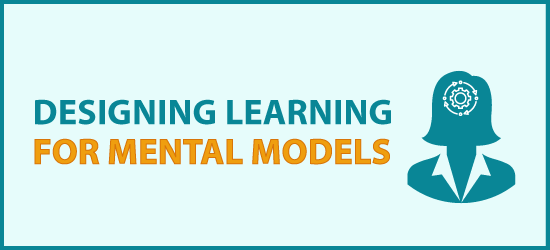
Did you have trouble the first time you tried to start a keyless car? Or perhaps the first time you took a panoramic picture? According to a well-known theory, these tasks were difficult because you had no mental models to guide you.
Mental models refer to the mental representations people form about the way things work in the external world. Cognitive scientists theorize that we rely on mental models to understand and interact with various systems of the world. This means we have thousands of mental models for everything from how to use a mobile phone to how to go through the security line at an airport or use an eLearning course.
They Help Us Understand and Predict
Psychologists think that mental models are activated when we need to solve problems or perform tasks (Halford, 2014). Without these conceptualizations, you would have to figure things out from the start each time you encountered a new situation or a new problem. Thus, having internal models of the external world helps us make predictions and inferences about how things work. It also helps us understand and explain phenomena and ultimately, decide what actions to perform (Johnson-Laird, 1983).
You can also look at these mental representations through the lens of a system. Rouse (2015) explains mental models as, “the mechanisms whereby humans are able to generate descriptions of system purpose and form, explanations of system functioning and observed system states, and predictions of future system states.”
Exploring Mental Models Provides New Insights
Mental models are an important concept that learning experience designers can take into consideration during the analysis and design process. Learning about the user’s mental models can help us improve user interfaces, learning interventions and the overall learning experience. Through interviews and discussions with audience members, we can discover common misconceptions and knowledge gaps in their mental representations. This may give us new insights into performance problems. In general, mental model theory is one way to help learning designers gain insight into how a specific audience thinks. See Leverage How the Brain Works.
Constructing Mental Models
How do psychologists think that we construct mental models? They may form from any of the following:
- direct interaction with a situation you’ve encountered
- through observation of how something works or
- through indirect experience, such as reading about a system or device, making inferences or hearing what others say about it.
Therefore, mental models can be based on beliefs as well as experiences. And they can be updated as a person gains competence.
Once constructed, we retrieve a mental model from memory and apply it to a new situation through analogical thinking. Analogies are mappings from one mental representation to another (Halford, 2014). When encountering a problem, a mental model will influence what a person pays attention to and the actions and strategies that a person takes to solve a problem.
Features of Mental Models
They are incomplete. Psychologists and user experience experts think that mental models are often incomplete and approximate. They are subject to inaccuracies and lack of detail. For example, if you have no medical background, your mental model of how the heart pumps blood is most likely incomplete. As you read an article on exercise and the heart, your mental model of the heart system will integrate a few more details. But it will still not be complete or accurate.
They are unstable. According to Jakob Neilson, mental models are in flux and unstable. They may be mixed up with other mental models. For example, if you’ve used two different devices for the same task, such as two different digital tablets, you might combine these models. This mixed up mental model may help you complete a task, but the model won’t be a perfect match to the system.
Matching the Conceptual Model with the Learner’s Mental Models
In the worlds of product and user interface design, they speak of the designer’s conceptual model, which is the product or interface design you present to the user. For example, if you were to use an ATM metaphor to teach banking concepts in an eLearning course, the ATM’s user interface would be considered the conceptual model. If the user interface of the ATM is very similar to the learner’s mental model of how an ATM works, the learner would consider the user interface intuitive (Hall, 2014).
On the other hand, if the ATM interface were very different than the learner’s mental model of an ATM, it could be frustrating to learn how to use the interface. Ease of use typically equates with a good match between the conceptual mental model and the user’s mental model. Thus, designers need to take the user’s mental model into consideration. Otherwise, a mismatch can cause frustration and confusion, which detract from the learning experience.
Filling in the Gaps of the Learner’s Mental Models
Mental models are important to consider when you are generating ideas for instructional strategies. Suppose you were to design instruction for a new procedure that is different from anything the audience has previously encountered. For example, suppose the members of a workforce always punched a time clock to track their hours at work. Everyone had a mental model of how the machine and the process worked.
Now the company is asking people to track their time using a mobile app. Users will need to construct a new mental model of how to track their hours. By understanding the mental models of audience members, such as how they understand mobile apps as well as the mental model of their old punch clock system, you may be able to design an instructional strategy that builds on their current understanding of these systems.
How to Identify a Learner’s Mental Models
As we all know, it’s not that easy to get into the mind of a learner. Here are some approaches that may help you understand the mental models of learners and users:
- Interview users from different target audiences to find out how they think about and/or use a system.
- Observe how audience members complete a task.
- If the mental model relates to a specific procedure, ask the audience member to speak aloud while performing the procedure. Record this or take notes.
- Consider asking a few audience members to diagram a quick sketch of how something works.
- Review data that shows how people carry out an action or respond during an interaction. This may be a good reason to use xAPI statements for generating data.
See UX techniques for understanding users.
Document the different mental models you uncover for each group. Consider if the mental models are very specific or general. Which type is most important for improving performance?
Diagram the different mental models as a flowchart or by grouping the parts of the model using sticky notes. As you review the mental models you’ve uncovered, identify inaccuracies that need correction, gaps that need to be filled and steps that need a new structure. Provide instruction and support to correct these issues.
Note that some mental models exist below the surface of awareness and will not be accessible. In those cases, you will need to make inferences based on observable behaviors or data.
Conclusion
Examining and understanding the mental models of your audience is one more way to improve and enhance instruction. Our toolbox of techniques is overflowing. Pick the right approach for your needs. For more on this topic, see Wikipedia.
References:
- Faranello, Scott. Practical UX Design. Packt Publishing, 2016.
- Halford, Graeme S.. Children’s Understanding: The Development of Mental Models, Taylor & Francis Group, 2014.
- Hall, Erika. Just Enough Research, A Book Apart, May 16, 2014.
- Johnson-Laird, P.N. Mental Models. Cambridge, MA: Harvard University Press, 1983.
- Neilson, Jacob. Mental Models, 2010. https://www.nngroup.com/articles/mental-models/.
- Rouse, William B. Modeling and Visualization of Complex Systems and Enterprises: Explorations of Physical, Human, Economic, and Social Phenomena. John Wiley & Sons, 2015.

Wow. Thanks for sharing the details, Tracy.
Thanks for this article Connie! One way I support filling in gaps in mental models is with metaphors. I often begin an instructional design project with a curriculum-wide metaphor. It helps me organize my design and if I build it into the curriculum, it supports learners’ understanding of the relationship of parts to whole. Often learners pick this up and make it their own, building out the metaphor. In edits, I build in their ideas. The most powerful example of this is the journey metaphor for the Parenting Inside Out curriculum I designed for criminal justice involved parents. This metaphor relates the components of parenting to taking a road trip. This supports, enriches and builds out the parents’ mental model of parenting. The initial metaphor had Destination Adulthood, the Backbone Parenting Highway, guardrails for child guidance practices, road signs, cars as kids, and gas station attendants as parents. The parents themselves (often incarcerated) added detours and potholes to represent the challenges they were encounter due to prison or substance use. We tell the story of parenting on the first day of class with parents putting up the pieces to the metaphor on the wall as they share about their kids, hopes and dreams. Then the metaphor lives on the classroom wall and acts as a graphic organizer for the length of the course. Parents pick up the language of the metaphor and use it when they speak with family court judges and parole officers, noting the “guardrails” they used in their parent-child visits, how they were making best use of their “detour”, and what “roadsigns” they were creating to guide their kids towards the hopes and dreams they held for their kids at “Destination Adulthood”.
Hi Jeff,
I thought I covered that in this article, LOL, but I guess not. Yes. I think visualizations are very good to show the way things operate: all kinds of diagrams and illustrations. If the mental models are complex, I’d consider a series of scaffolding activities that take place over time. Also, it might be effective to have people practice using their mental model via scenario-based activities that get increasingly more complex. I think one of the best opportunities for identifying misconceptions is if you can find a way to discover the common inaccuracies in their mental models and then fix those through instruction. People can also benefit from working closely with mentors and being paired with experienced employees.
I’m not exactly sure the types of mental models you are working with, Jeff, but I’m guessing they are quite complex?
Connie
Any thoughts on how to teach people useful mental models so they can perform their job(s) better, Connie?